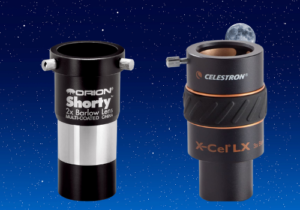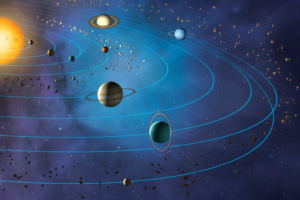8 Best Deep Space Objects In Cassiopeia To View
Disclosure: This post contains affiliate links and I may earn a small commission (at no extra cost to you) if you click through and make a purchase. Thanks in advance – I really appreciate it!
Cassiopeia is a large constellation located in the northern sky, and it is the 25th largest constellation in the sky.
Cassiopeia is easily recognizable for the prominent W asterism formed by its five brightest stars, hence the constellation Cassiopeia has been nicknamed W.
The stars that make up this constellation are Epsilon, Ruchbah (Delta), Gamma, Schedar (Alpha Cassiopeiae), and Caph (Beta Cassiopeiae).
Schedar is the brightest star in the constellation, with a visual magnitude of 2.24. It is an orange giant star located 228 light years from Earth. Caph is the second brightest. With a magnitude of 2.28, it is believed to be a blue-white giant star 28 times brighter than the Sun.
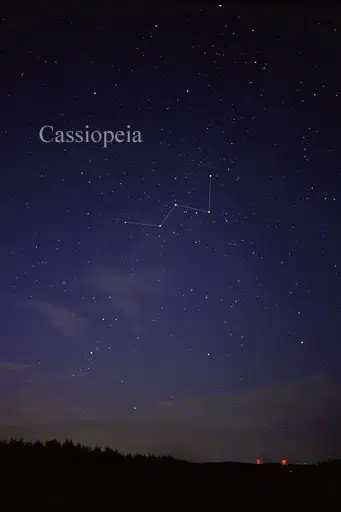
The ‘W’ shape of Cassiopeia Credit: wikimedia.org
Key Takeaways:
Which Deep Sky Objects Are In Cassiopeia?
The constellation Cassiopeia contains many interesting deep-sky objects, such as:
We will discuss each of them in detail later in the article, or you can click on any of them to jump to their respective section in the article.
Cassiopeia Mythology
Cassiopeia is named after the queen of a country on the northern coast of Africa, Aethiopia (not modern Ethiopia).
She boasted that she and her daughter Andromeda were more beautiful than the Nereids, the 50 sea nymph attendants of Thetis, the sea goddess, and Poseidon, the sea god.
So as a punishment, Andromeda, Cepheus, and Cassiopeia were placed next to each other among the stars as punishment after enraging Poseidon.
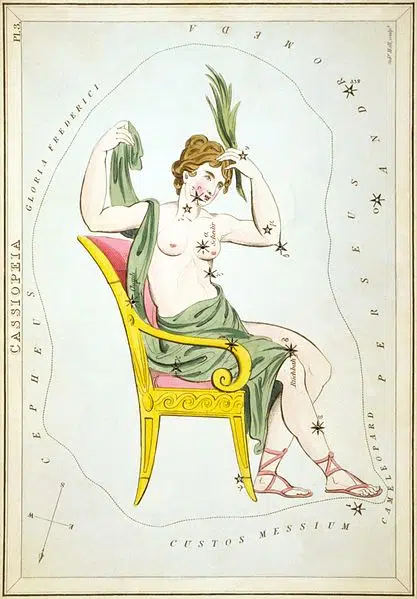
Cassiopeia the vainglorious queen seated on her throne. Credit: wikimedia.org
It was Poseidon who placed Cassiopeia and Cepheus in the sky. Cassiopeia, the myth goes, was condemned to circle the celestial pole forever and spends half the year upside down in the sky as punishment for her vanity.
She is usually depicted on her throne, still combing her hair.
Cassiopeia Location
- Abbreviation: Cas
- Genitive: Cassiopeiae
- Right Ascension: 1-hour
- Declination: 77.69 degrees
- Area in Square Degrees: 598
- Crosses Meridian: 9 PM, November 20
- Visible Between Latitudes: 90 and -20 degrees
They have good center sharpness but exhibit some field curvature and astigmatism.
Edge sharpness is just satisfactory, nothing to boast about, as is the apparent field of view. They are most useful in medium and longer focal lengths for terrestrial, planetary, and lunar viewing.
Major telescope brands such as Celestron supplies Kellner eyepieces with their r least expensive telescopes and still may.
The constellation Cassiopeia is the 25th largest constellation in the night sky and can be seen in the northern hemisphere all year long. It is visible at latitudes between 90 degrees and -20 degrees.
Since it is located close to the north celestial pole, it is completely below the horizon for anyone located south of -20 degrees. It is a mid-sized constellation occupying 598 square degrees.
You may refer to this star chart to easily locate and observe the constellation Cassiopeia and the deep-sky objects in it.
The constellation Cassiopeia can be found high in the northeast on October evenings, not far from Polaris, the North Star. At any time of year, you can use the Big Dipper to find Cassiopeia.
These two-star formations are like riders on the opposite side of a Ferris wheel. They’re part of a great spinning wheel of stars seen moving counterclockwise around Polaris, the North Star, once daily.
As Cassiopeia rises upward, the Big Dipper plunges downward, and vice versa.
Cassiopeia belongs to the Perseus family of constellations, along with Andromeda, Auriga, Cepheus, Cetus, Lacerta, Pegasus, Perseus, and Triangulum.
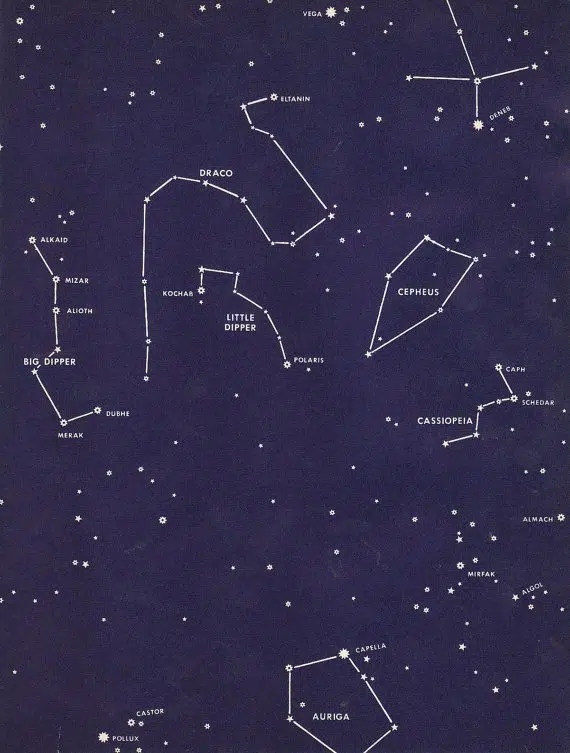
Deep Sky Objects In Cassiopeia
Cassiopeia is one of the most easily recognizable constellations due to its distinctive W or M shape, and there are several notable deep-space objects in Cassiopeia.
1. Messier 52
Messier 52 (M52) is a bright open cluster located in the constellation Cassiopeia. The cluster has an apparent magnitude of 6.9 and lies at an approximate distance of 4,600 light-years from Earth.
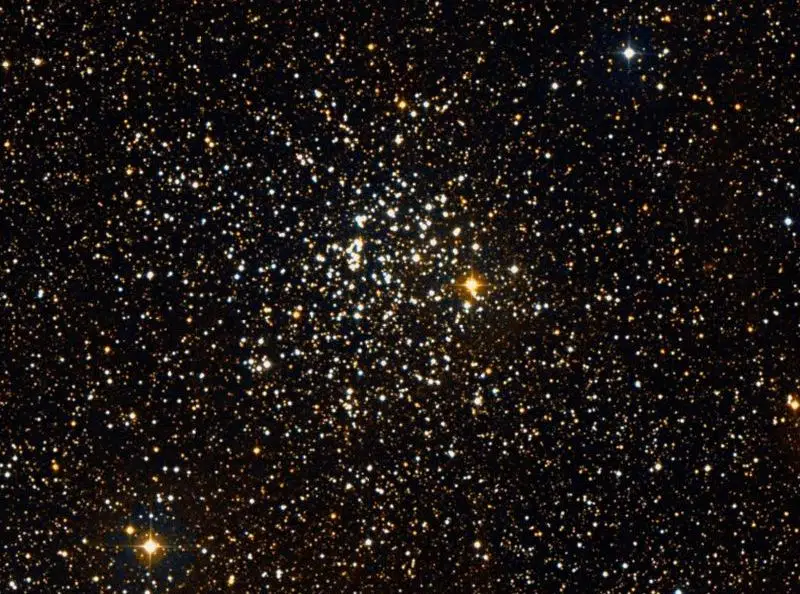
Messier 52 star cluster. Credit: universetoday.com
Messier 52 can easily be seen with binoculars, where it appears as a hazy, nebulous patch of light.
A small 4-inch telescope reveals a dense, compressed star cluster populated by many faint stars with a shape resembling that of the letter V.
You can see many more stars if you have a telescope that is 6-inch or larger. The cluster occupies an area just less than half of the size of the full Moon.
The cluster can be located by extending the line from Schedar, Alpha Cassiopeiae, to Caph, Beta Cassiopeiae to the northwest, about the same distance as that between the two stars. The cluster lies only a degree south of star 4 Cassiopeiae.
Here’s a star chart to help you easily locate the Messier 52 star cluster.
The best time of year to observe it is during autumn.
2. Messier 103
Messier 103 (M103), also known as NGC 581, is an open star cluster. It is located about 10,000 light-years away, spanning about 18 light-years across. It can be found in the constellation Cassiopeia.
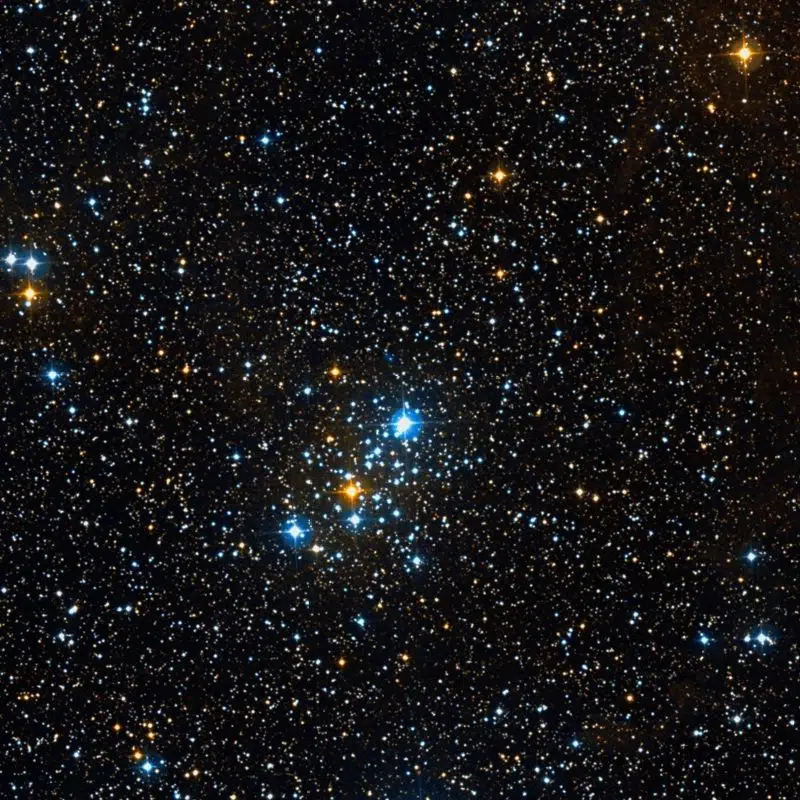
Messier 103 NGC 581 star cluster. Credit: messier-objects.com
It is easy to see, even with binoculars, and appears as a nebulous fan-shaped patch. 4-inch telescopes resolve the four brightest stars in the cluster.
Large telescopes resolve more stars across the cluster, but make it harder to make out M103 from the surrounding star field because the cluster is quite loose.
Locating M103 is fairly easy, even under moderately light-polluted conditions. Simply identify Delta Cassiopeiae (Ruchbah), a bright, blue-white star that marks one of the lower positions of Cassiopeia’s class “W” asterism.
Simply center it in the finderscope and look about 1/2 a degree north and 1 degree east in the direction of Epsilon.
Or, you may follow this star chart to locate Messier 103 in Cassiopeia.
3. The Heart Nebula
The Heart Nebula (IC 1805) is a large emission nebula in the constellation Cassiopeia.
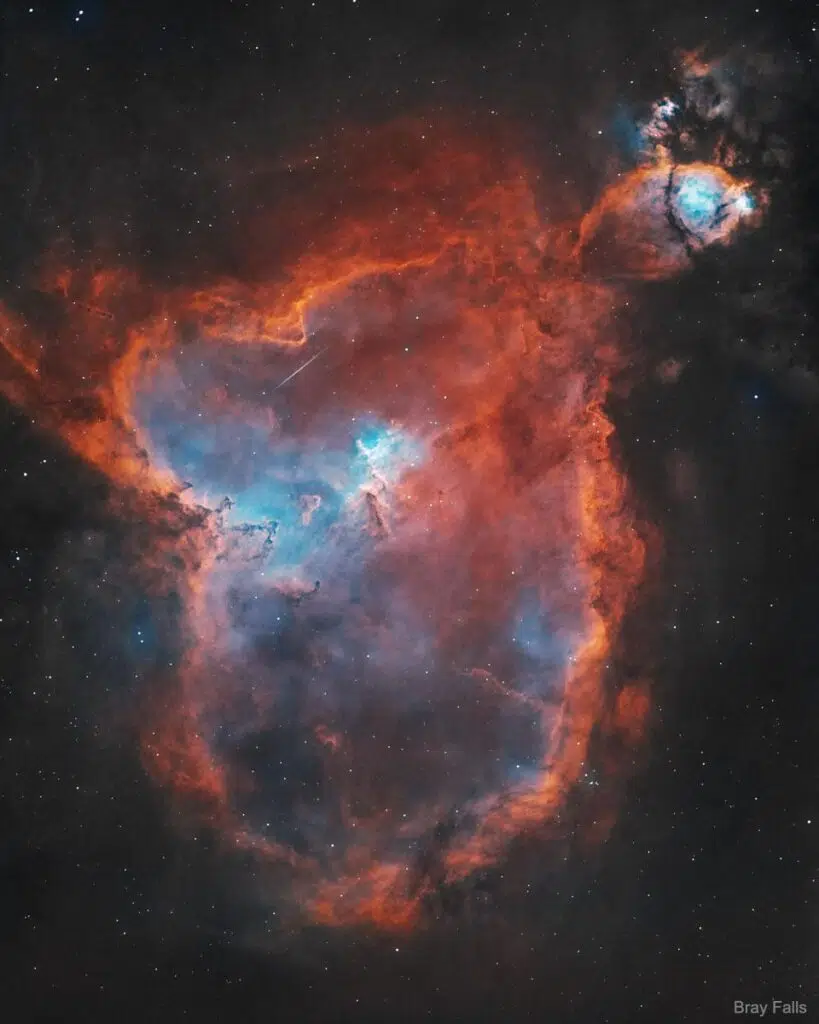
The Heart Nebula. Credit: NASA
This glowing nebula gets its nickname from the familiar shape it resembles and is located approximately 7,500 light-years from Earth.
The nebula was given its name, the Heart Nebula, because of its intensely red glowing gas and dark dust lanes that form a shape that resembles a heart symbol.
At the center of the Heart Nebula is an open star cluster called Melotte 15, which contains bright stars that are about 50 times as massive as our own Sun.
The stars of Melotte 15 are blasting the surrounding hydrogen and causing it to emit light, powering the Heart Nebula’s beautiful glow.
The Heart Nebula is located in the vicinity of Maffei 1 (PGC 9892) and Maffei 2 (UGCA 39), which are the brightest galaxies in the IC 342/Maffei Group — the nearest galaxy group to our Local Group.
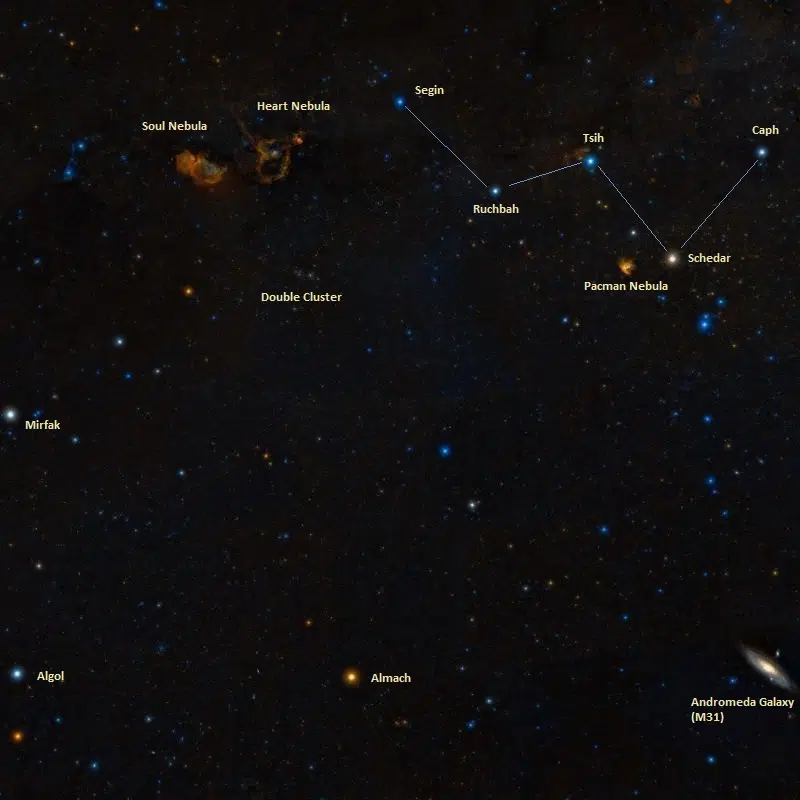
The Heart Nebula location. Credit: constellation-guide.com
The Heart Nebula forms a famous complex known as the Heart and Soul with its smaller neighbor Westerhout 5, also known as the Soul Nebula, which lies just 2.5 degrees to the southeast.
4. The Soul Nebula
The Soul Nebula (Westerhout 5) is an emission nebula located in the constellation Cassiopeia. It forms a famous pair known as the Heart and Soul with the neighboring Heart Nebula (IC 1805).

The Soul Nebula. Credit: astrobackyard.com
The Soul Nebula is an emission nebula with an open star cluster embedded within it. It is a vast star-forming region containing clouds of dust and gas being illuminated by the light of the surrounding young stars.
It contains several small open star clusters. IC 1848 is embedded in the body of the nebula, while the clusters CR 34, 632, and 634 can be seen in the head. Small emission nebulae IC 1871, 670, and 669 are located just next to the Soul Nebula.
If you intend to observe or photograph the Soul Nebula in the Cassiopeia constellation, you can refer to this star chart.
The Heart and Soul Nebulae are located in the Perseus arm of our galaxy, the Milky Way, and stretch about 600 lightyears across.
5. The Ghost of Cassiopeia
The Ghost of Cassiopeia nebula, also called IC 63, drifts 550 light-years from Earth in the constellation Cassiopeia.
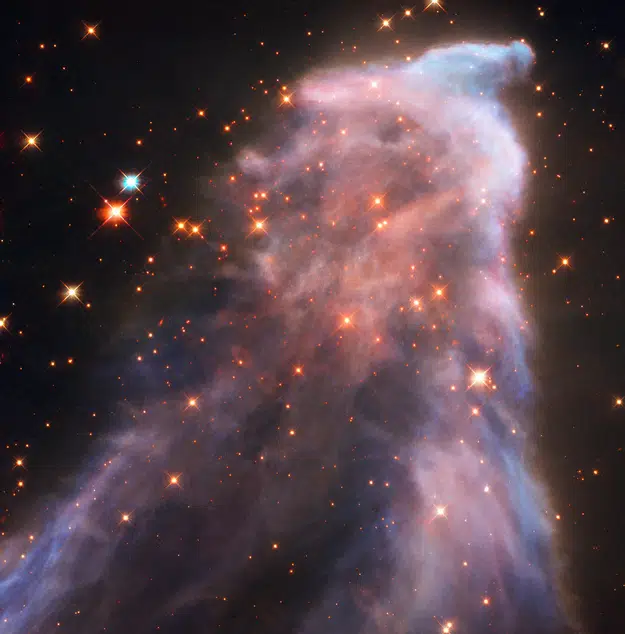
The Ghost of Cassiopeia nebula. Credit: sci.esa.in
The Ghost of Cassiopeia is a very faint nebula that is barely visible due to its proximity to the bright star Gamma Cassiopeiae.
The remarkable Gamma Cassiopeiae is a blue-white subgiant variable star that is surrounded by a gaseous disc. This star is 19 times more massive and 65 000 times brighter than our Sun.
The radiation of Gamma Cassiopeiae is so powerful that it even affects IC 63, sometimes nicknamed the Ghost Nebula, which lies several light years away from the star.
6. The Bubble Nebula
The Bubble Nebula is 7 light-years across – about one-and-a-half times the distance from our sun to its nearest stellar neighbor, Alpha Centauri – and resides 7,100 light-years from Earth in the constellation Cassiopeia.
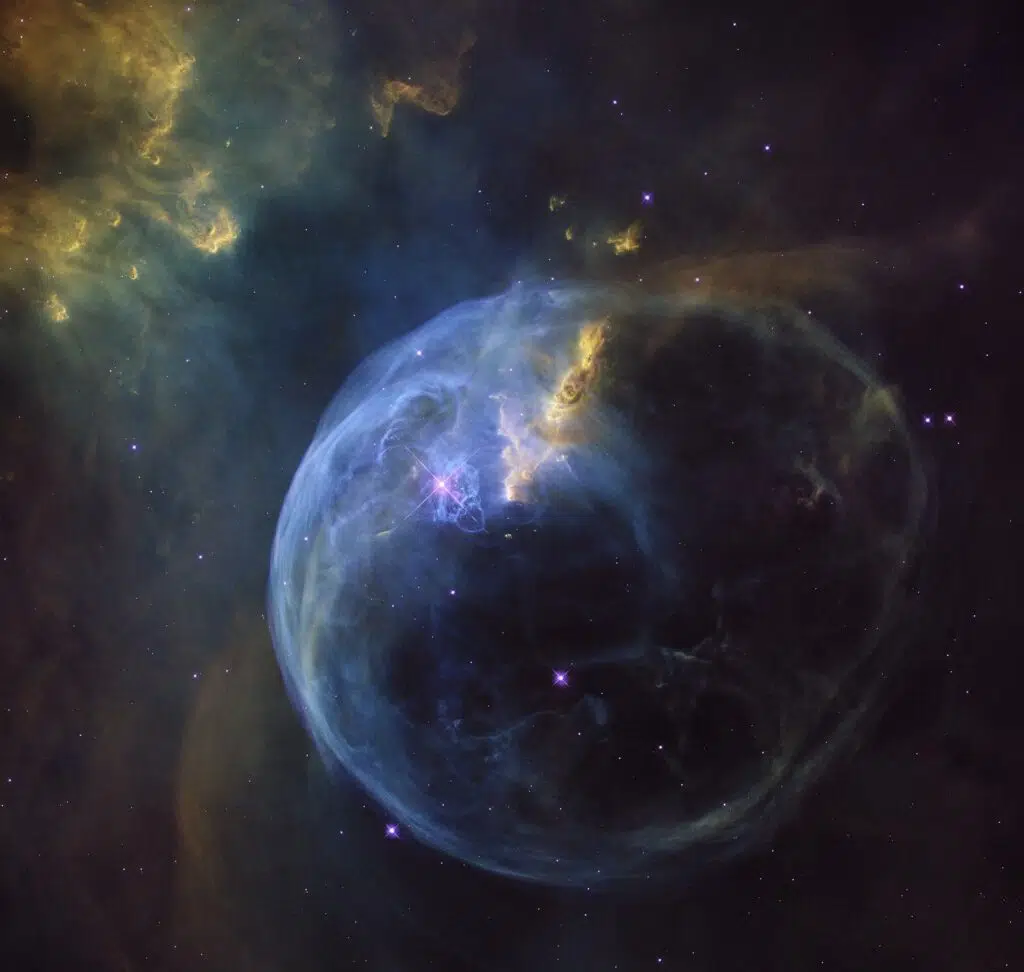
Bubble Nebula in Cassiopeia. Credit: wikipedia.org
The Bubble Nebula is also known as Sharpless 162 and Caldwell 11. This emission nebula sits within a giant, glowing molecular cloud. The Bubble itself is about 10 light-years in diameter.
The Bubble Nebula lies very close to the open star cluster known as Messier 52 in Cassiopeia.
This remarkably-spherical looking cosmic cloud is the result of a giant star that’s 45 times as massive as our own Sun and glows a million times brighter.
The star emits streams of charged particles known as stellar winds out into space at speeds of about 4 million miles an hour.
With an 8-inch telescope, the Bubble nebula appears as a large faint shell of light that’s brightest around the central star.
Here’s a star chart to assist you in locating the Bubble Nebula.
7. The Lobster Claw Nebula
SH2-157, also known as the Lobster Claw Nebula, is an emission nebula located about 11,000 light-years away in the constellation of Cassiopeia.
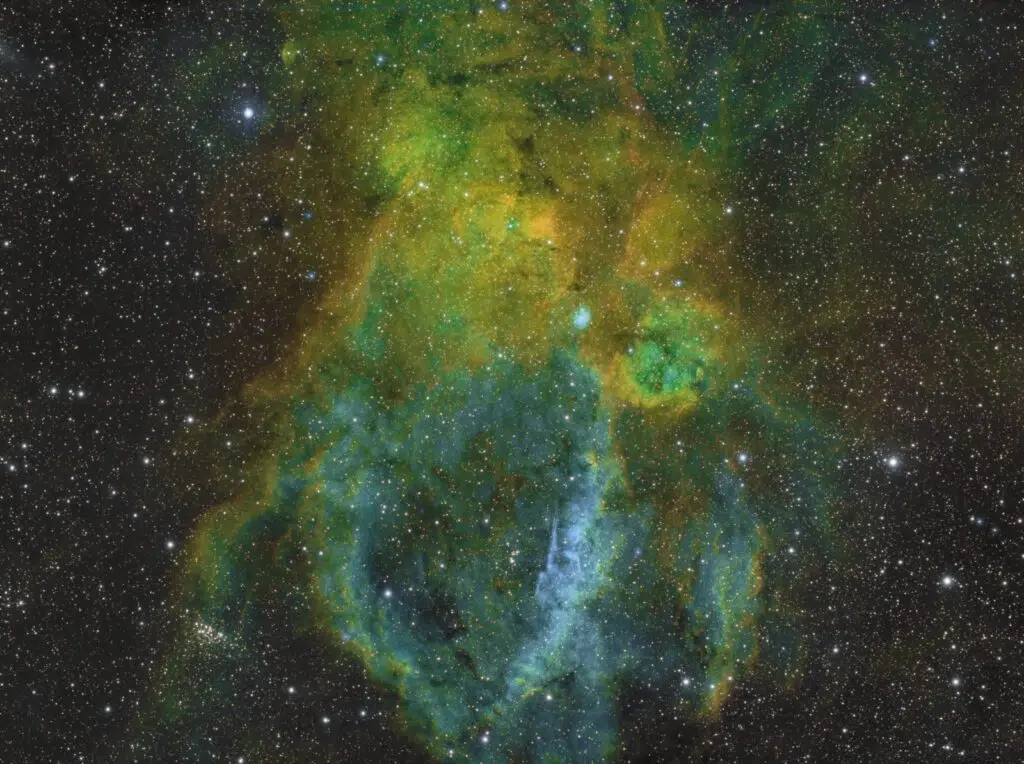
Lobster Claw Nebula in Cassiopeia. Credit: astrodoc.ca
The predominantly yellow part of the nebula is a very large H II region that is ring-shaped by the stellar wind of several giant stars, including the bright and very young Wolf-Rayed star WR 57.
The small bright region at the left and up of center of the image is Lyn’s Bright Nebula 537 (LBN537 or Sharpless 157a).
The blue colored regions at the right part of the image mainly consist of highly ionized oxygen (OIII) and other gases. The small open star cluster NGC 7510 is located at the bottom right part.
It sits very close in the sky to the Bubble Nebula (NGC 7635) which is another popular emission nebula for amateur astronomers.
8. The Pacman Nebula
The Pacman Nebula (NGC 281) is a cosmic cloud of space gas located in the constellation Cassiopeia.
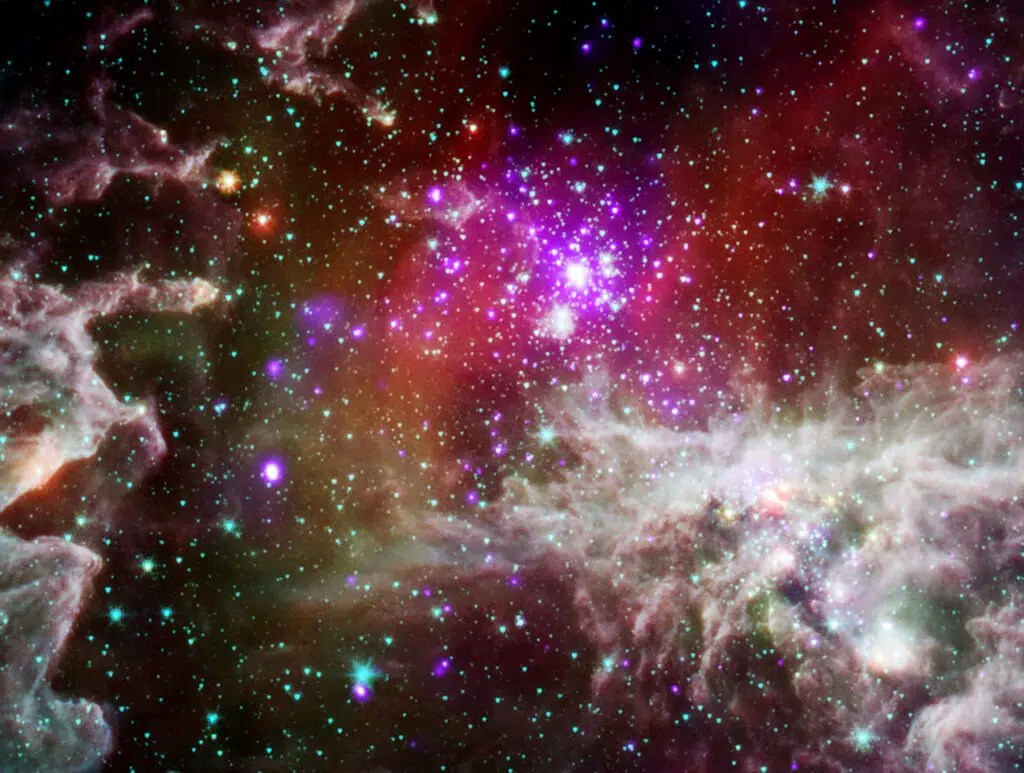
Pacman Nebula in Cassiopeia Constellation. Credit: X-ray: NASA/CXC/CfA/S.Wolk; IR: NASA/JPL/CfA/S.Wolk
The nebula lies approximately 9,200 light years away and occupies 35 arcminutes of the apparent sky. It was named the Pacman Nebula for its resemblance to Pac-Man, the character in the popular 1980s maze video game.
NGC 281 is a star cluster containing high-mass stellar specimens that emanate powerful streams of charged particles known as stellar winds into space.
Visible in the center of the Pacman Nebula is a young open cluster, IC 1590. It is faint but easily visible in photographs.
You might also be able to spot in with a pair of binoculars or a telescope if observing from a very dark site.
The cluster is home to more than 279 stars and illuminate the gases around it that shape the Pacman Nebula.
The Pacman Nebula is very easy to find because it lies near Cassiopeia’s W, one of the most distinctive asterisms in the northern sky.
It appears just east (left) of Schedar (Alpha Cassiopeiae), the bottom right star of the “W,” and south of the binary star Achird (Eta Cassiopeiae). The nebula is easily visible in small telescopes.
Conclusion
So this was a list of all the main deep sky objects in Cassiopeia. Cassiopeia is one of the most interesting constellations in the night sky. It has many popular and bright deep sky objects, and is high in the sky for a long period of time.
Deep sky objects in Cassiopeia can be seen throughout the year in the northern hemisphere. The best time of year to observe them is during the month of November, when the constellation is high overhead in the evening sky.
Written by:

Kavya Joshi
My love affair with space began in a field in India at the age of 7, when I looked up at the Milky Way for the first time. Ever since, I have been attempting to cram in every fact about the Universe, I can find into my head.
ABOUT US
We are a team of active amateur astronomers, here to help you with all your astronomy and science related needs – this is anything, from reviewing the latest telescopes to be released to talking about gravity and neurons. The Big Bang Optics was started because of our love for astronomy and to help others like us find the best telescope and accessories.
LEGAL DISCLAIMER
The Big Bang Optics is a participant in the Amazon Services LLC Associates Program, an affiliate advertising program designed to provide a means for sites to earn advertising fees by advertising and linking to Amazon.com. The Big Bang Optics also participates in affiliate programs with Clickbank and other sites. The Big Bang Optics is compensated for referring traffic and business to these companies.

